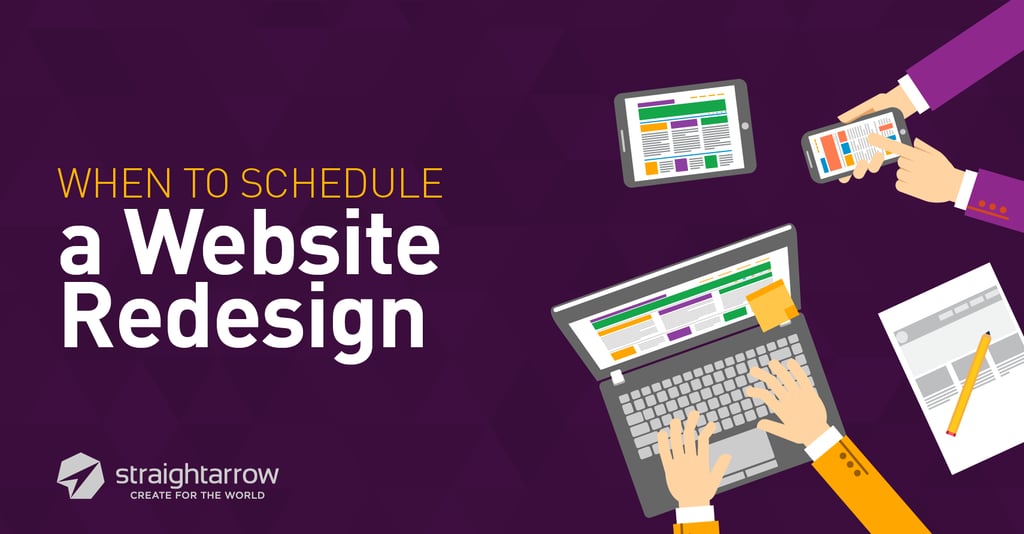
Sometimes thrilling, sometimes daunting, but certainly never dull—such is the prospect of a website redesign. A bearer of branding, lure of leads and caller of customers, the website almost always lies at the heart of a company’s online presence, fed by tributaries from ads, search engines and social media. With such importance placed on it, even a small change can have considerable effects. And with so many functions, there are almost innumerable possibilities for change.
This panoply of options is part of what makes redesigning a website so alluring—there’s always a question of “What if something else works better?” The pursuit of excellence is admirable, of course, but there are also several good reasons to put off the overhaul, such as users’ general aversion to change, and, well, the reasons you chose your website’s design in the first place.
This is not to say that change should be a medicine administered rarely and reluctantly—only that it should be administered after proper diagnosis. There are a number of good reasons to change a website, including some that you might have to heed even when you’re otherwise satisfied with your virtual presence. Read on for some of the main points to consider in website redesign.
Raising the Bar
Before redesigning your website—and this applies no matter what your final reason might be—you should have a goal. It might be growing site traffic, increasing your conversion rate, reducing your bounce rate, and so on. Seeing as many of these statistics affect each other, your goal will likely involve some composite of various factors. And since such goals aim for measurable adjustments, it’s necessary that you have reliable statistics before embarking on your redesign.
A site might be redesigned with aesthetic goals, but it’s good to pair these with more functional goals. Aesthetic elements are subjective, after all, and a site’s owner is more likely to tire of the design than the customer is—much like how a full-time shopkeeper would find a physical store more tiresome than a customer who’s there just an hour each week or so.
Repurposing
Your site’s purpose might change from time to time, reflecting changes in your broader marketing or online strategies. This change might be an addition of features or a removal of some. It is important, therefore, to regularly affirm whether your website’s goals and key indicators are aligned with its function in your broader plans—if not, you may need to update them, and along with that, alter the website itself.
Integration
Conversely, the website may have adapted to suit your evolving strategy by adding functions, sections, content and more. And while incremental expansion or alteration is good to avoid alienating old users, it can—and often does—lead to bloat and convolution. A comprehensive website redesign that integrates features into a more cohesive, intuitive whole will benefit users in the long run, and improved website experience is likely to redound to your business’ benefit.
Mobile Responsiveness
People view web pages around half as often on mobile devices as they do on desktops and laptops—but the percentage of views on mobile is growing, while more traditional computers are seeing their share decline. Add to this the prioritization on search engines of mobile responsive websites, and benefits of responsiveness are clear as day. If your website is not yet mobile responsive, addressing the issue should be one of your top concerns.
Changing or Updating Tools
Most business websites rely on a number of third-party tools to fulfill certain functions. Virtual tools, like their material counterparts, can lose their edge over time. If key tools in your website are no longer meeting expectations and you choose to adopt new ones, a redesign may help in better integrating them. The more central those tools are to the site’s function, the more an redesign should be considered.
The Competition has Changed
You don’t need to match every rival’s redesign with one of your own, but if a major competitor is making strides, it may be worth examining their newfound strengths and mixing these with your own ideas for improving. This is especially true if your competition’s website changes gave them significant boosts in areas you also wanted to grow in.
As Part of an Ongoing Strategy
Not all redesigns are radical overhauls. In fact, most changes in your website design should be gradual and incremental, so that returning customers are not shocked to find once-familiar pages all of a sudden impenetrably confusing. When possible, limit changes to a few pages, or a few elements across pages, and see how these work. Rolling out changes gradually minimizes risk and allows you to measure results reliably in a more or less controlled environment.
If you’re thinking of redesigning your website and looking for an agency to do it, schedule a consultation call with our team of experts and see how you can find a team in line with your business objectives.




Comments